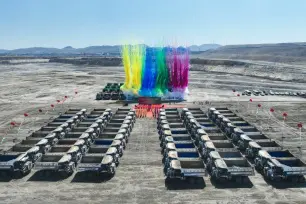If you had been away from the planet for the past quarter of a century, one of the few things you might find comfortingly familiar on your return is the world of sport. While the digital revolution has transformed the way we shop, chat, date, do politics and consume culture, sport looks largely unchanged.
From football to cricket to golf, it’s still the same old staples, hitting a ball into a hole or goal or over a boundary. There hasn’t been a major new sport invented for more than a century. Or has there?
In the East End of London, Sam Mathews is holding court at Fnatic’s HQ, otherwise known as the Bunkr. A pop-up shop that opened last December, it is marketed as the “world’s first eSports concept store” and is as knowingly hip as its Shoreditch surroundings. Here at the Bunkr, you can buy eSports equipment, meet players, view streamed events and even watch matches live.
ESports consist of a variety of video games, for which you need nimble fingers and a fast brain to succeed. Just as with traditional sports, fans follow teams, watch matches and even attend cup finals, cheering on their favourite stars from around the world. Mathews founded Fnatic 13 years ago, with financial support from his mother, and has built it into one of the world’s most successful teams, competing in more than 600 tournaments globally, in games such as Counter-Strike, Dota2, Call Of Duty, Overwatch and League of Legends. Fnatic’s League of Legends team won the first world championship in 2011 and its Counter-Strike team are considered one of the best of all time, though few of the players are British. In truth, British players are not yet good enough to compete at the top level. “eSport is the first world sport outside of football that is truly global,” Mathews says.
Already, football clubs such as Manchester City have started signing Fifa stars who are players of the virtual game, rather than the real thing. The most ambitious clubs, such as Paris Saint-Germain, have signed up a whole squad of players in a number of different eSports, including League of Legends. The thinking is simple: digital gaming is where the next generation of fans will come from (often, a young person’s first interaction with a professional football club is through the Fifa game), and so eSports are a vast reservoir of future income.
The revenue from eSports is expected to rise from $130m (£100m) in 2012 to $465m (£365m) this year, according to Newzoo, the eSports data expert. The global audience will reach 385 million this year, made up of 191 million regular viewers and a further 194 million occasional viewers. ESports stars such as the South Korean player Faker, who has just turned 21, are already paid up to £2m a year, and that’s not including bonuses and sponsorship. But will they ever compete with, say, Lionel Messi and Cristiano Ronaldo? And should we be worried if they do?
Poland’s eSports ‘Olympics’
The vast Spodec stadium in Katowice, south west Poland, is humming with activity. It is February, and this saucer-shaped building is host to the world’s biggest eSports event. Thousands of boys and young men (nearly everyone is male) gather to watch the Intel Extreme Masters finals, a kind of annual Olympics.
It is much more than a tournament. The halls are crammed with companies showing off their latest wares; visitors can try out new games on elevated seats that revolve 360 degrees. The noise is deafening – constant explosions and the rat-at-at-at of guns – while the screens light up with every new kill. You wouldn’t come here to find peace.
The professional eSports companies and players come here to make big bucks, while sponsors attend in the hope of tapping into tomorrow’s market. (Britain hosts its equivalent at Wembley Arena, but it is small fry by comparison.) The Fnatic team is competing against the top Korean, American and European teams. Fnatic might be British-based, but it is regarded as a global company; few British players are good enough to compete at the top level.
This is the fifth year the Intel finals have been held in Katowice. Once a weekend-long event, it now takes place over two weekends. This year’s figures are record-breaking: 173,500 attending, more than 46 million viewers watching online (up 35% from last year).
The event is the most widely broadcasted in the history of ESL, the eSports company that organises competitions worldwide. In 2015, Swedish media company Modern Times Group acquired a majority stake in ESL for $87m. That figure already looks like a bargain. ESL broadcasts its competitions on Twitch, the leading eSports streaming service. In 2014, only three years after it was founded, Twitch was bought by Amazon for $970m. Another bargain: this is a huge business.
Fans watching a game on the big screens during the Intel Extreme Masters Counter-Strike eSports tournament at Katowice’s Spodek Arena in March 2017. Photograph: Tom Jenkins for the Guardian
What has astonished people – even those who dreamed it up in the first place – is the extent to which gaming has become a spectator sport. ESL founder Ralph Reichart blinks in disbelief at the thousands of young men staring at screens inside the Spodec. “We thought, let’s just build this stage and it’s going to be great.” He smiles. He didn’t expect it to be this great. “Most people thought we were crazy, including my father and my peers.”
The Intel Masters was founded in 2006, and Reichart puts its growth down to four factors: social media, live streaming, a faster internet, and the longevity of more established games. There is something fantastical about the way Katowice, this redundant mining town barely 30 miles from Auschwitz, has become an emblem of tomorrow’s world. Reichart explains how it happened. “Five years ago, the mayor contacted us. He said, ‘We have a fantastic stadium called Spodec, and our city is changing. It used to be all mining, and now we want it to become an entertainment city – video games can help’.” Nowadays, Katowice is largely known for the Intel masters, which Reichart calls the Woodstock of eSports. “Some music festivals are more special and longer-lasting than others, and Katowice is like that. It’s more than a festival - it’s a movement.”
Seoul searching
If you want to get to the heart of gaming, you don’t go to Poland – you go to South Korea, the cradle of eSports. It’s Friday night in Seoul and I’m spending it the way many Korean youngsters do: at a PC bang. PC bangs are gaming cafes and by 9pm this one is packed. Many of the youngsters here will play through the night. The hundreds of computer screens are all busy. Most people are playing the hugely complex League of Legends; some, simpler shoot-’em-ups such as Counter-Strike; others are playing Fifa. You can buy energy food and drinks, cooked meals, alcohol, and there is a smoking room. You can spend as long as you like without ever needing to leave.
The teenagers and twentysomethings are too absorbed in their games to chat to each other. However, some play team games that involve talking animatedly to strangers in different parts of the world. PC bangs were initially opened by the South Korean government, keen to promote the internet and gaming. Apart from taekwondo, South Korea did not have a national sport and eSports presented an area in which they could excel (the country has one of the fastest and most developed broadband networks in the world). Today, PC bangs are not only cafes; they are the parks and playgrounds of South Korea.
Jeong Hyeon-seok is an impressive young man, a 28-year-old maths teacher who is about to leave for the United States to do a PhD in brain science. He comes here three or four times a week, staying for two to four hours each time; occasionally, he stays overnight. Jeong says it’s cheap compared with other forms of entertainment and exhilarating. Like many men, he says, he is reserved and awkward in conversation, but here he feels happy, uninhibited.
Gamers in a PC bang in the Hongdae area of Seoul in March 2017. Photograph: Tom Jenkins for the Guardian
He is not embarrassed about visiting PC bangs but he does not tell his father where he goes. It’s a generational thing, he explains. “The older generation think of eSports and gaming as something that people who have failed would do to waste their time. Parents would expect you to do something productive; to study.”
Why is there such a high proportion of male to female players? “Girls prefer chit-chatting in a coffee shop. Boys don’t do much chit-chatting,” Jeong says. Playing a team game at a bang provides a release. He can hook up with strangers and share a common goal: defeating the enemy. Jeong is transformed when he starts playing Overwatch, a team game that involves transferring goods to different areas and, of course, killing. He speaks fast and excitably, barking instructions to anonymous team-mates. When he finishes, he looks exhausted and is out of breath. Does he feel good? “Yes. You feel good if you’ve won a football match. It’s like that.”
Schooling future superstars
Ahyeon polytechnic high school is the equivalent of a sixth-form college and takes students who have struggled in the mainstream. When the principal, Bang Seung-ho, realised many students were bunking off because they had spent all night playing games, he took radical action: he opened a PC bang in the school. So long as students studied regular subjects in the morning, they could play eSports to their hearts’ content in the afternoon and evening.
Bang, a charismatic man who could pass as a film star, believed having a PC bang on tap would prove an incentive for students to attend school. And so it did. The students were transformed. “It was incredible to see how good their attitudes towards the classes became,” he says. “Once you embraced those kids, recognising what they are good at, their mentality changed. They started studying as well.”
Bang became something of a star in the process. He had always considered himself a singer-songwriter, sidetracked from his destiny, so he wrote a song about eSports addiction. Don’t Worry became a hit in South Korea.
Meanwhile, at his school, the youngsters became better and better at games as they trained with a talented peer group. Before long, Bang realised the school was becoming a training ground for future professionals.
He takes me to the PC bang where the students (all boys) are too absorbed to look up. How many want to become professionals? Now they look up. Everybody raises their hand instantly. How many hours a day do they need to dedicate to games to succeed? The very minimum, they agree, is 10 hours a day. So far, seven or eight of Bang’s students have turned professional. “I always say: ‘You have to give me a percentage of your earnings,’ but they never do!” He grins.
Bang does not like to use the word addiction for problem users; he prefers overindulgence. I ask if he would rather be remembered for curing overindulgence or for creating eSports stars. “Both. The school can cure the students and train them to become a professional beyond the cure.” But if he had to choose one? For once, Bang is lost for words. Finally, he answers: “If I really have to choose between curing and training to become a professional, it would be the latter.”
‘It cannot be good for your health’
The Sangam eSports stadium in Seoul looks like a cross between a cinema and a conventional sports stadium. One of the biggest eSports teams, SK Telecom (owned by the telecoms operator), is playing a qualifying League of Legends match, and I can’t hear myself think for explosions. The huge screen is a dizzying array of electric pinks, blues, purples and yellows. League of Legends fans tell me it took them months to understand it: it’s a strategy game set in a fantasy arena with three or five players on each side, which involves destroying towers and killing opponents, but there is no obvious way to distinguish the two teams. I cannot tell who is attacking whom, though the neon scoreboard keeps me abreast of what is happening. The crowd is young and more than 50% female. This is surprising, because League of Legends, like all eSports, is male-dominated.
Most of the girls are here to see Faker, SK Telecom’s star mid-laner (status-wise, the equivalent of a central midfielder in football). The team has the appeal of a boy band. Faker is not only SK Telecom’s leading player, he is the biggest star in League of Legends, full stop. Even I can tell he has something special about him; he tends to score and assist with more kills than other players. But there is something else: he is deceptive, subtle, appearing out of nowhere to strike with a swirling flourish. The crowd roars and claps him on. He may be a superstar, but he looks like most eSports players: bespectacled, spotty, exhausted and pasty-faced. You sense he may not have seen the sun for years.
I follow Faker past the crowds of selfie-chasing girls to a private room. He wears a stylish red and white jacket with his nickname inscribed on the back in capital letters (his real name is Lee Sang-hyeok: “I thought Faker sounded cool,” he says). He is a sweet and sombre young man, determined to answer every question as fully as he can.
I ask whether it is his reaction speed that makes him such a good player. “No. Actually, my reaction velocity isn’t so good. What’s more important is concentration.” In some ways, he says, League of Legends is like chess or the abstract strategy board game Go, but in others it resembles traditional team sport games. “It is like football and basketball, in that strategies become more important than individual skills as you go to a professional level.”
Faker enjoys his fame. He recently went to Seattle and began to understand the scale of his success when he was recognised in the streets. That gave him a buzz, he says. Is it true he will only marry a girl who is as good at League of Legends as he is? He smiles. “What I said about my ideal woman was a joke, but people actually believe it now, which makes me worry about my future.”
How many hours a day does he put into League of Legends? “I practise a minimum of 12 hours a day. Sometimes 15 hours a day when it’s close to a match.” Does he get bored? “I am still enjoying it but probably not as much as I was before I became a professional. Yes, I do, I get a bit bored.” But, he says, that is a small quibble. He knows how lucky he is.
Does Faker think of himself as a sportsman? “You don’t always have to use your physical mobility in sport,” he says. “So, to that extent, I think it’s a sport – apart from the perception that eSports damages your health.”
Is that a fair perception? “As you sit for long hours without much movement, inevitably it cannot be good for your health, but I do believe it contributes to brain development.”
It’s 10pm and the world’s leading League of Legends player has to return to the team house. When I get back to my hotel, I turn on my television. The first channel I flick to is showing today’s SK Telecom match. There are endless replays, analysis of Faker’s form, interviews with the players. Suddenly, the scale of League of Legends hits me. This channel shows eSports for 24 hours a day. I am watching South Korea’s Match of the Day.
Death by a thousand games
It has not been easy to get time with the chairman of the Korean eSports Association. Jun Byung-hun is a busy man. He is also the chairman of the International eSports Federation – possibly the most important man in this world. Finally we meet at his office in Seoul. He is wearing a smart black suit and shoes you can see your reflection in.
Jun’s ambition is to make eSports as popular worldwide as they are in South Korea, and he sees little standing in his way. “Older people think games poison the youth and take time from their studies, but this is wrong,” he says. “It is like stopping the flow of a river. The support policy should be to help the water not to flood, and lead them in the right paths. By doing so, we can maximise the effectiveness of the regulations.”
In truth, Jun is not a big fan of regulation. In 2011, the Korean government acknowledged the country had a problem with young people addicted to gaming and introduced the Cinderella law, which forbids children under the age of 16 from playing computer games between midnight and 6am. Jun is contemptuous of it. “The Cinderella law is anachronistic. I’ve been vigorously campaigning to eradicate it. Games should be established as a leisure culture within family. Trying to restrict them creates bigger side-effects.” He looks at his watch. His minders say he has to leave.
Jun Byung Hun, the President of the Korean eSports Association and President of the International eSports Federation. Photograph: Tom Jenkins for the Guardian
Before he does, I ask if eSports should be in the Olympics. “Yes, of course. It should have the same status as sport.” For the chairman, it is not a question of if, but when: eSports will be included in the official programme of the 2022 Asian Games. “In the digital era, eSports will not just be established as a major sport, but also the most beloved sport.”
At the National Centre for Mental Health in Seoul, Dr Lee Tae-kyung knows exactly why the government introduced the Cinderella law. Lee is in charge of the addiction department at the government-run psychiatric hospital. He used to deal mainly with drug and alcohol addiction but today it’s all about gaming. Problems typically emerge, he says, when children enter middle school, at the age of 11. They lose interest in academic work, friends and family; they stop sleeping; they eat poorly or hardly at all. “There was a young man who immersed himself without sleeping or having meals, and finally he died after finishing his game,” Lee says. “People asked whether we should ban internet gaming or restrict players’ times after this case. But the harsh regulations depress the industry.”
Does he think the government is doing enough to tackle addiction? “No. I support the Cinderella law but it is not enough.” He describes the industry’s lack of support for addicts as “immoral”.
Lee treats his patients with a programme he has created called Hora, after a character in Momo, a fantasy novel written by the German author Michael Ende in the 1970s. Momo is about an eponymous girl whose life is ruined by the arrival of a species of paranormal parasites that steal time from humans. Momo and the human race are eventually rescued by their saviour, Hora, who returns time to them. For Lee, the story of Momo is the perfect metaphor.
Choi is an addict and an inpatient at Lee’s hospital. He is 31 but seems younger. He talks gently and movingly about how his addiction alienated him from the real world and his job assisting an interior designer. He says he played at PC bangs for four to six hours every night, and stopped eating properly.
Did his habit affect the quality of his work? “Very much. My work could be quite dangerous, because some of the materials are very sharp and need special attention, but I was feeling so sleepy, the designer was worried about me.”
He says he began to confuse his own identity with characters in the games he played. He stopped relating to people. At the hospital, he has undergone music and poetry therapy. Choi talks about a particular poem that has had a profound effect on him, in which the poet sends a letter to a loved one on a lettuce leaf. He smiles as he thinks about it. “When I was playing games in which I was only killing, breaking, attacking, I was not really living, not thinking about my family. I realised it would be beautiful if I could return to normal life.”
Choi has no intention of giving up games but he hopes when he leaves the hospital he will be able to play in moderation. Lee’s conservative literary therapy seems effective but he is not overly optimistic. “Choi is in remission but the temptation will always be there.”
Other therapies are more radical. The Easy Brain Center in downtown Gangnam is a private clinic, apparently modelled on easyJet; it even uses a similar orange and white motif. This is where desperate parents with money bring their children when they have run out of hope.
Dr Kim Hyun-soo is less formally dressed than doctors at the government-run hospital. He talks about how patterns of addiction have changed in South Korea. “In the 1990s, the addiction issues were associated with glue or gas. In 1998, internet games were commercialised, and in 2000 I started seeing gaming addicts. Many of the glue and gas sniffers moved on to gaming. Since then, the top-ranked addiction among young people is game addiction and 90% of the addicts are male teenagers.”
Kim has a kindly face and a gentle laugh that belies some of the terrible stories he tells. He talks about the addicts he has seen who wear nappies so they don’t have to leave their game to go to the toilet; the gamers so obsessed that they stop eating and sleeping altogether. And then there are the horror stories, those that made the news all over the world. He says he was one of the psychiatrists on a committee that investigated the case of a games-addicted young man who killed his mother before killing himself. “There have been many tragic social cases that are related to game addiction.”
One case that particularly affected him involved a 23-year-old addict whom Kim successfully weaned off eSports in 2005. “I treated him for six months and thought he was cured.” But he killed himself two months after completion of the treatment. “We realised he had wanted to keep the relationship with his gaming friends but he was chucked out of that community. The fact that he thought he had lost all his social relationships led to his suicide.” It was a painful lesson for Kim. “I realised it wasn’t a simple issue of not playing the game at all – it’s not black and white. I had to go much deeper into the psyche.” He discovered there were different types of gaming addictions: some people were addicted to moving up the ranks; some to the money-making aspect; and some to that sense of belonging to the gaming community.
Those addicted to the money side, he says, are most difficult to treat. Gambling in eSports already seems more advanced than in traditional sports. Professional players have been banned for betting on themselves to win matches or, more commonly, to lose. Last year, one of the biggest names in Starcraft, Lee “Life” Seung-hyun, was imprisoned after being convicted of match-fixing. He has been banned for life from eSports in South Korea.
Kim says younger and younger people are becoming addicted. He has seen six-year-olds refusing to go to school because they are addicted to smartphone games. He treats his patients with “talking therapy”: addicts talk out their problems and hopefully reach a solution. If they are addicted to the competitive element, Kim may suggest an analogue sport that would suit them; if they play because they are lonely, he may suggest they join a small community less prone to addiction. It is a moderate approach to treating addiction.
I ask if he will give me the most powerful shock he gives patients. The impact is violent. I still feel it hours later
But that is only half the story. Next door, his partner, Dr Lee Jae-won, sits in a room full of terrifying, hi-tech gadgetry. When talking does not work for youngsters, he turns to electric shock treatment. One machine delivers basic shocks to stimulate the frontal lobe; the other provides transcranial magnetic stimulation, a less brutal therapy. These treatments, particularly the first, are controversial, especially when used on young people. But Lee insists his treatment is much more sophisticated than the crude electroconvulsive therapy of yesteryear. As he talks, he regularly flicks a switch, gives himself an electric shock and twitches. He seems unaware that he is doing it.
How old are the youngest people he treats? “There are kids who are obsessed before they enrol in their elementary school. With gaming, it is the frontal lobe that degenerates. And it is the frontal lobe that makes humans act like humans. So having it damaged makes them antisocial, impulsive and unhappy.” The electric shock stimulates the frontal lobe, he explains.
I ask if the brain zap is random. Yes, he says, but it does not matter. “If one part of the brain is stimulated, the surroundings will get stimulated accordingly, too.”
I ask if he will give me the most powerful shock he gives patients, on my hand. It’s only a single zap, but the impact is violent. My bones resonate as if struck by a tuning fork. I can still feel it hours later. These shocks are meant to be applied to the head.
On the way out, I see a little boy, possibly nine years old, in the waiting room with his mother. The boy has a League of Legends tattoo on his arm. This is a cultural taboo in Korea, where tattooing is illegal, and a clear sign the boy is far gone. I wonder whether he will get the talking therapy, electric shock or both. This is the flipside to the glamorous world of Faker, the packed out stadiums, the fans and the multimillion-pound deals.
Fans watching the League of Legends eSports match between Rox Tigers and SK Telecom at the Seoul eSports Stadium. Photograph: Tom Jenkins for the Guardian
Policing the opportunists
Ian Smith, the British first head of the eSports Integrity Commission (Esic), says it is the wild west out there. The world of eSports is exciting, largely unregulated and ripe for exploitation. It’s his job to make sure things don’t get out of hand. Smith, the former legal director of the Professional Cricketers’ Association, has plenty of experience of dealing with corruption, not least spot- and match-fixing.
In eSports, cheating is relatively easy, he says. You can slow opponents down using technology that messes with their internet connection, or take drugs to speed yourself up. Or you can simply lose. And it is becoming increasingly susceptible to corruption, because so many people are betting on matches. The casinos in Las Vegas are now streaming matches to attract young people. In March, Esic signed a memorandum with the Nevada Gaming Control Board to share information about suspicious betting patterns. Next year, the Luxor hotel will become home to the first eSports arena on the Las Vegas strip.
Smith wants eSports to benefit from the lessons learned in other sports: “We can save time and bypass the pain,” he says, “because traditional sport has already gone through this. You will get guys riding it, coming in and looking at the money. They are already doing it. The industry can say, we don’t want Fifa, we don’t want Sepp Blatter, a bunch of corrupt old men telling us what to do and making millions off us. But what do they want? At the moment, they have no idea.”
Is the industry supportive of his ethics code? “I have been accused more than once of building a highway for cars that don’t yet exist. The trouble is, I know the cars are coming, because I’ve spent 20 years looking at them. People want to wait until they’re run over by that car.”
In Britain, we are just starting out on the eSports road. Traditional sport still dominates, yet every day new evidence emerges of change. BT Sport is broadcasting the Fifa 17 Ultimate Team Championship Series in the UK for the first time this year. Last month, Tottenham Hotspur announced their new ground will host live eSports matches, with potential crowds of 50,000 and revenues of £3m a match.
While the London Olympics were intended to “inspire a generation” to play sport, it has emerged the number of people playing traditional sport or exercising at least once a week in the UK has dropped 0.4% since 2012, to 15.8 million. In March, a YouGov poll revealed 91% of parents said their children did not get the recommended 60 minutes of physical activity a day. They worry their children are lost in sedentary, virtual worlds. Korea’s problems may seem a world away but it is already seven years since the UK’s first eSports addiction clinic opened, in Weston-super-Mare, Somerset. British therapists may prefer a 12-step programme to electric shock treatment but who knows what the future holds?
(GUARDIAN)
 简体中文
简体中文












